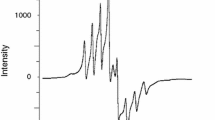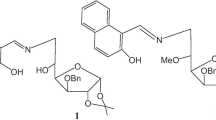Abstract
Schiff-bases of metformin with each of salicylaldehyde (HL1); 2,3-dihydroxybenzaldehyde (H2L2); 2,4-dihydroxybenzaldehyde (H2L3); 2,5-dihydroxybenzaldehyde (H2L4); 3,4-dihydroxybenzaldehyde (H2L5) and 2-hydroxynaphthaldehyde (HL6) and their complexes with Pr(III) were synthesized by template reaction. The complexes were characterized through elemental analysis, conductivity and magnetic moment measurements, IR, UV-Vis., fluorescence, GC-MS and XRD spectroscopy. The complexes exhibit a series of characteristic emission bands for Pr3+ ion in the 481-472 and 590-580 nm range with a 318-332 nm excitation source. The complexes have eight coordinated structure with the formulae [PrL1-4,6(NO3)2(H2O)3].nH2O where n = 1, 1½, 3, 4, 4 and [PrL5(NO3)(H2O)5].2H2O. The suggested stereochemistry was confirmed using TGA, DTG and DTA analysis and a mechanism for thermal decomposition was proposed. Coates-Redfern equation was used to calculate kinetic and thermodynamic parameters of the main decomposition step. The utility of the complexes towards the detection of glucose at physiologically relevant pH in phosphate buffer using UV-Vis and fluorescence spectroscopy as well as viscosity measurements are tried where the association constants were calculated.

ᅟ








Similar content being viewed by others
References
Stepensky D, Friedman M, Srour W, Raz I, Hoffman A (2001) Preclinical evaluation of pharmacokinetic–pharmacodynamic rationale for oral CR metformin formulation. J Control Release 71:107–115
Babykutty PV, Parbhakaran CP, Anantaraman R, Nair CGR (1974) Electronic and infrared spectra of biguanide complexes of the 3d-transition metals. J Inorg Nucl Chem 36:3685–3688
Subasinghe S, Greenbaum AL, McLean P (1985) The insulin-mimetic action of Mn2+: involvement of cyclic nucleotides and insulin in the regulation of hepatic hexokinase and glucokinase. Biochem Med 34:83–92
Zhu M, Lu L, Yang P, Jin X (2002) Bis(1,1-di-methylbiguanido)copper(II) octahydrate. Acta Crystallogr E58:m217–m219
Patrinoiu G, Patron L, Carp O, Stanica N (2003) Thermal behaviour of some iron(III) complexes with active therapeutically biguanides. J Therm Anal Calorim 72(2):489–495
Olar R, Badea M, Cristurean E, Lazar V, Cernat R, Balotescu C (2005) Thermal behavior, spectroscopic and biological characterization of co(II), Zn(II), Pd(II) and Pt(II) complexes with N,N-dimethylbiguanide. J Therm Anal Calorim 80(2):451–455
Al-Saif FA, Refat MS (2013) Synthesis, spectroscopic, and thermal investigation of transition and non-transition complexes of metformin as potential insulin-mimetic agents. J Therm Anal Calorim 111:2079–2096
El-Megharbel SM (2015) Synthesis, Characterization and Antidiabetic Activity of Chromium (III) Metformin Complex. J Microb Biochem Technol 7:65–75
Gao JA (2007) A weak hydrolytical copper(II) complex derived from condensation of N,N-Dimethylbiguanide with 2-Pyridinecarbaldehyde synthesis, crystal structure and biological activity. Synth React Inorg Met-Org Nano-Met Chem 37(8):621–625
Olar R, Badea M, Marinescu D, Iorgulescu E, Stoleriu S (2005) Ni(II) complexes with ligands resulted in condensation of N,N-dimethylbiguanide and pentane-2,4-dione. J Therm Anal Calorim 80:363–367
Mahmoud MA, Zaitone SA, Ammar AM, Sallam SA (2006) Structure and antidiabetic activity of chromium(III) complexes of metformin Schiff-bases. J Mol Struct 1108:60–70
Mahmoud MA, Zaitone SA, Ammar AM, Sallam SA (2017) Synthesis, spectral, thermal and insulin enhancing properties of oxovanadium(IV) complexes of metformin Schiff-bases. J Therm Anal Calorim 128:957–969
Mahmoud MA, Ammar AA, Sallam SA (2017) Synthesis, characterization and toxicity of cu(II) complexes with metformin Schiff-bases. J Chin Adv Mat Soc 5:75–102
Taha ZA, Ajlouni AM, Al-Hassan KA, Hijazi AK, Faiq AB (2011) Syntheses, characterization, biological activity and fluorescence properties of bis-(salicylaldehyde)-1,3-propylenediimine Schiff base ligand and its lanthanide complexes. Spectrochim Acta A81:317–323
Kapoor P, Fahmi N, Singh RV (2011) Microwave assisted synthesis, spectroscopic, electrochemical and DNA cleavage studies of lanthanide(III) complexes with coumarin based imines. Spectrochim Acta A83:74–81
Kostova I, Manolov I, Momekov G (2004) Cytotoxic activity of new neodymium (III) complexes of bis-coumarins. Eur J Med Chem 39:765–775
Łyszczek R (2012) Hydrothermal synthesis, thermal and luminescent investigations of lanthanide(III) coordination polymers based on the 4,4′-oxybis(benzoate) ligand. J Therm Anal Calorim 108:1101–1110
Yi-Bo Z, Yang N, Liu W-S, Tang N (2003) Synthesis, characterization and DNA-binding properties of La(III) complex of chrysin. J Inorg Biochem 97:258–264
Wang ZM, Lin HK, Zhu SR, Liu TF, Zhou ZF, Chen YT (2000) Synthesis, characterization and cytotoxicity of lanthanum(III) complexes with novel 1,10-phenanthroline-2,9-bis-[agr]-amino acid conjugates. Anticancer Drug Des 15:405–411
Aime S, Crich SG, Gianolio E, Giovenzana GB, Tei L, Terreno E (2000) High sensitivity lanthanide(III) based probes for MR-medical imaging. Coord Chem Rev 250:1562–1597
Figgis NB, Lewis J (1960) In: Lewis J, Wilkins RG (eds) The Magnetochemistry of complex compounds. Interscience, New York
Geary WJ (1971) The use of conductivity measurements in organic solvents for the characterization of coordination compounds. Coord Chem Rev 7:81–122
Nakamoto K (1997) Infrared and Raman spectra of inorganic and coordination compounds: applications in coordination, organometallic, and bioinorganic chemistry, 5th edn. Wiley, New York
Kumar DS, Alexander V (1995) Macrocyclic complexes of lanthanides in identical ligand frameworks part 1. Synthesis of lanthanide(III) and yttrium(III) complexes of an 18-membered dioxatetraaza macrocycle. Inorg Chim Acta 238:63–71
Ankolekar VN, Mahale VB (2000) Synthesis and Spectroscopic Investigations of Lanthanide(III) Nitrate Complexes with Ligands Obtained from 2,6-diformyl-4-methylphenol. Synth React Inorg Met-Org Chem 30:1193–1209
Alaudeen M, Prabhakaran CP (1996) Synthesis and characterization of iron(III) complexes of N-(2-thienylidene )-N'-isonicotinoylhydrazine, N-(2-furylidene)-N'-salicyloylhydrazine and N-(2-thienylidene)-N'-salicyloylhydrazine. Indian J Chem A35:517–519
Muraleedharan Nair MK, Radhakrishnan PK (1996) Synthesis and physicochemical studies of yttrium and lanthanide nitrate complexes of 1,2-(diimino-4-antipyrinyl)ethane. Proc Ind Acad Sci (Chem. Sci) 108:345–350
Pearson RG (1936) Hard and soft acids and bases. J Am Chem Soc 85:3533–3539
Carlin RL (1986) Magnetochemistry. Springer, New York
Tandon SP, Mehta PC (1970) Study of Some Nd3+ Complexes: Interelectronic Repulsion, Spin–Orbit Interaction, Bonding, and Electronic Energy Levels. J Chem Phys 52:4896–4902
Ambroziak K, Rozwadowski Z, Dziembowska T, Bieg B (2002) Synthesis and spectroscopic study of Schiff bases derived from trans-1,2-diaminocyclohexane. Deuterium isotope effect on 13C chemical shift. J Mol Struct 615:109–120
Issa RM, Khedr AM, Rizk HF (2005) UV–vis, IR and 1H NMR spectroscopic studies of some Schiff bases derivatives of 4-aminoantipyrine. Spectrochim Acta A62:621–629
Jørgensen CK (1957) Absorption spectra of dysprosium(III), holmium(III), and erbium(III) Aquo ions. Acta Chem Scand 11:981–989
Carnall WT, Fields PR, Rajnak K (1968) Electronic energy levels in the trivalent lanthanide Aquo ions. I. Pr3+, Nd3+, Pm3+, Sm3+, Dy3+, Ho3+, Er3+, and Tm3+. J Chem Phys 49:4424–4442
Pandey UK, Pandey OP, Sengupta SK, Tripathi SC (1987) Syntheses and spectroscopic studies on TETRAAZA MACROCYCLIC complexes of praseodymium(iii). Polyhedron 6:1611–1617
Davies GM, Aarons RJ, Motson GR, Jeffery JC, Adams H, Faulkner S, Ward MD (2004) Structural and near-IR photophysical studies on ternary lanthanide complexes containing poly(pyrazolyl)borate and 1,3-diketonate ligands. Dalton trans 1136-1144; Voloshin AI, Shavaleev NM, Kazakov VB (2001) luminescence of praseodymium (III) chelates from two excited states (3P0 and 1D2) and its dependence on ligand triplet state energy. J Lumin 93:199–204
Yan B, Zhang HJ, Zhou GL, Ni JZ (2003) Different thermal decomposition process of lanthanide complexes with N-phenylanthranilic acid in air and nitrogen atmosphere. Chem Pap 57:83–86
Carp O, Gingasu D, Mindru I, Patron L (2006) Thermal decomposition of some copper–iron polynuclear coordination compounds containing glycine as ligand, precursors of copper ferrite. Thermochim Acta 449:55–60
Nyquist RA, Kagel RO (1971) Infrared spectra of inorganic compounds. Academic Press, New York
Coats AW, Redfern JP (1964) Kinetic parameters from thermogravimetric data. Nature 201:68–69
Frost AA, Pearson RG (1961) Kinetics and mechanism. Wiley, New York
Wells AF (1984) Structural inorganic chemistry, 5th edn. Science Publications, Oxford
Steiner M-S, Duerkop A, Wolfbies OS (2011) Optical methods for sensing glucose. Chem Soc Rev 40:4805–4839
Alptürk O, Rusin O, Fakayode SO, Wang W, Escobedo JO, Warner IM, Crowe WE, Král V, Pruet JM, Strongin RM (2006) Lanthanide complexes as fluorescent indicators for neutral sugars and cancer biomarkers. Proc Natl Acad Sci U S A 103:9756–9760
Yang L, Su Y, Xu Y, Zhang S, Wu J, Zhao K (2004) Interactions between metal ions and carbohydrates: the coordination behavior of neutral erythritol to zinc and europium nitrate. J Inorg Biochem 98:1251–1260
Battistini E, Mortillaro A, Aime S, Peters JA (2007) Molecular recognition of sugars by lanthanide (III) complexes of a conjugate of N, N-bis[2-[bis[2-(1, 1-dimethylethoxy)-2-oxoethyl]amino]ethyl]glycine and phenylboronic acid. Contrast Media Mol Imaging 2:163–171
Lu Y, Deng G, Miao F, Li Z (2003) Metal ion interactions with sugars. The crystal structure and FT-IR study of the NdCl3–ribose complex. Carbohydr Res 338:2913–2919
Wang W, Gao X, Wang B (2002) Boronic acid-based sensors. Curr Org Chem 6:1285–1317
Benesi HA, Hildebrand JH (1949) A Spectrophotometric Investigation of the Interaction of Iodine with Aromatic Hydrocarbons. J Am Chem Soc 71:2703–2707
Springsteen G, Wang B (2002) A detailed examination of boronic acid–diol complexation. Tetrahedron 58:5291–5300
Sun Y, Bi S, Song D, Qiao C, Mu D, Zhang H (2008) Study on the interaction mechanism between DNA and the main active components in Scutellaria baicalensis Georgi. Sens Actuators B: Chem 129:799–810
Author information
Authors and Affiliations
Corresponding author
Additional information
Publisher’s Note
Springer Nature remains neutral with regard to jurisdictional claims in published maps and institutional affiliations.
Electronic Supplementary Material
Supplementary data related to this article contain representative examples of: IR spectra (S1and S2), UV-Vis spectra (S3 and S4), fluorescence spectra (S5 and S6), mass spectra (S7) of the complexes.
ESM 1
(PDF 1665 kb)
ESM 2
(PDF 1889 kb)
ESM 3
(PDF 302 kb)
ESM 4
(PDF 456 kb)
ESM 5
(PDF 235 kb)
ESM 6
(PDF 299 kb)
ESM 7
(PDF 1743 kb)
Rights and permissions
About this article
Cite this article
Mahmoud, M., Abdel-Salam, E., Abou-Elmagd, M. et al. Template Synthesis, Spectral, Thermal and Glucose Sensing of Pr3+ Complexes of Metformin Schiff-Bases. J Fluoresc 29, 319–333 (2019). https://doi.org/10.1007/s10895-018-02341-5
Received:
Accepted:
Published:
Issue Date:
DOI: https://doi.org/10.1007/s10895-018-02341-5




